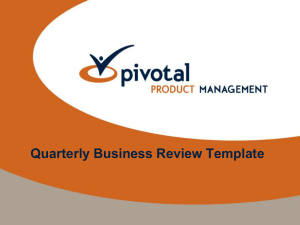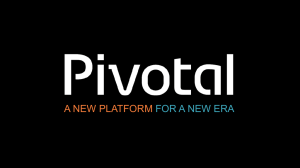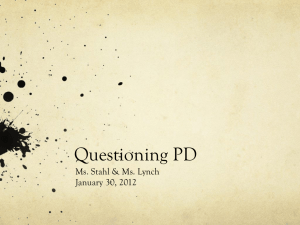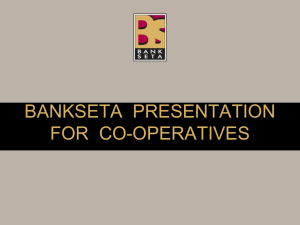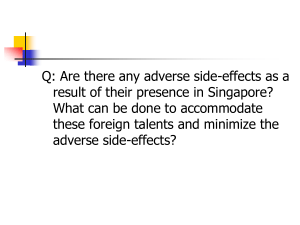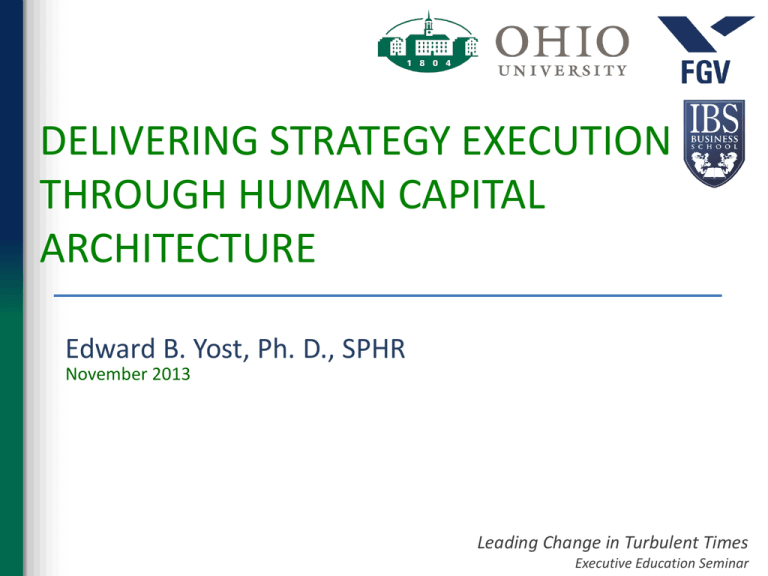
DELIVERING STRATEGY EXECUTION
THROUGH HUMAN CAPITAL
ARCHITECTURE
Edward B. Yost, Ph. D., SPHR
November 2013
Leading Change in Turbulent Times
Executive Education Seminar
Step #1
Determine the
Critical
Components
of Strategy
Execution
Strategic Success Hierarchy
Industry
Firm/Company
Business Unit/Function
Position
Person
Defining the Business Strategy
Strategy is:
The central, integrated, and
externally oriented concept of
how we will achieve our
objectives. (Hambrick & Fredrickson)
Strategic Success
Looking for operational, financial customer,
workforce success through…
Betting on the incompetence of competitors
Acquiring and utilizing the resources &
competencies of others
Using existing resources & competencies
differently
Organizational Resources and
Competencies
• Tangible and intangible resources
and capabilities that enable the
organization to develop, choose and,
implement value enhancing
STRATEGIES through resource
deployments, systems and processes that
cannot be imitated.
Strategy Simplified
Resources
Cost Advantage
Distinctive
Competence
Capabilities
Differentiation
Advantage
Value
Creation
What is Strategic Success?
Delivering high value results to
significant stakeholders
Financial Success = Market Value; ROI
Operational Success = Costs; Quality
Customer Success = Value Added
Workforce Success = Q.W.L.; Performance
What is “Strategic Competitive
Advantage?”
Enacted or Utilized Distinctive Competency that:
1. Allows the organization to differentiate itself
from competitors
2. Cannot be readily duplicated or imitated
3. Provides a positive economic benefit(s)
Action Item #1 Building the Strategy
1. What Resources does your
organization have?
2. What are your organization’s Key
Capabilities and Competency?
3. How are the resources,
capabilities and competencies
used to create value (the
strategy)?
Strategic Success Chain
The Ultimate Goal is Survival
Sustainability
Goes beyond the traditional financial
measures of firm performance and
shareholder value - focused on
achieving high levels of success in the
short term without compromising
the future
Strategic Success Chain
Strategy Execution
Competitive Advantage
Sustainability
Strategy Execution
• Enacted responses (behaviors) to internal
requirements and external constraints by
individuals and teams based on the
existing capabilities in the workforce
moderated by the underlying culture of
the organization that drives
organizational performance
We will see this again later!
Human Capital
Components
Strategy
Execution
Competitive
Advantage
Sustainability
Human Capital Capabilities
Human Capital Behaviors
Workforce Culture
(Performance Drivers)
Pivotal Positions
Pivotal Talent Pools
Constructing Human Capital Architecture
Strategic Direction
Pivotal Talent
Pool(s)
Strategy
Execution
Pivotal
Position
Pivotal Role
Challenges
Implement &
Adjust HCA
Congruence and
Consistency of HCA
Components
Capabilities
Behaviors
Culture
Step #2
Effectively
Managing,
Talent Pools,
Human Capital
and Pivotal
Positions
The Secret Revealed!
What is the SECRET of obtaining a
Strategic Competitive Advantage?
Not just having a strategy
but executing the strategy
All depends on the Human Capital
Architecture to enhance the exploitation
of these resources and capabilities.
Human Capital & Strategy Execution
A. Resources + Capabilities = Human
Capital
B. Systems + Processes + Practices =
Human Capital Architecture
C. Human Capital X Human Capital
Architecture = Strategy Execution
Talent Segmentation
• Talent segmentation involves identifying
pivotal talent pools where human capital
makes the biggest difference to strategy
execution
• Where would a significant improvement in
quality or availability make the BIGGEST
difference to strategy execution?
Pivotal Talent Pools
• Talent segmentation is as vital as
customer segmentation
• Pivotal Talent Pools are embedded in the
Primary and Support activities of the
Value Chain
The Value Chain
Research & Development Group
Critical Outcomes for Strategy
Execution at Big Pharma
1. New Product Applications
2. Reduce Time to Market
Focus on a Strategic Business Unit at
Big Pharma
Enables the Value
Proposition for
Stakeholders
Strategy Execution
Operations
Marketing
Research &
Development
Human Resources
Pivotal Talent Pools
• Identify two pivotal talent pools in your
organization using the “Value Chain Model”
Constructing Human Capital Architecture
Strategic Direction
Pivotal Talent
Pool(s)
Strategy
Execution
Pivotal
Position
Pivotal Role
Challenges
Implement &
Adjust HCA
Congruence and
Consistency of HCA
Components
Capabilities
Behaviors
Culture
Action Item #2
Pivotal Talent Pools and Critical
Outcomes (from item #1)
Pivotal Talent Pool
Critical Outcome A?
Critical Outcome B?
The Importance of Human Capital
Pivotal Talent Pools
Pivotal Positions
Determine the Pivotal Positions
to Deliver Strategy Execution
What is Human Capital?
Talents and abilities
Knowledge and skills
Social networks (capital)
Desire and visions
Human Capital Defined
The collective sum of the attributes,
life experience, knowledge,
inventiveness, energy, and
enthusiasm that people choose to
invest in their work.
Weatherly 2003
Human Capital Has Value
“People are our most valuable asset
INVESTORS!”
PROVE IT! Must be demonstrated by
management practices and actions
that compose the Human Capital
Architecture
Human Capital and
The Bottom Line
• To create value through Human Capital
requires a fundamental change in how it is
recognized and managed in most
organizations.
• The firm’s human assets have a value that
corresponds to the present value of future net
cash flows and are derived from the skills,
motivation and adaptability of the firm’s
workforce.
Constructing Human Capital Architecture
Strategic Direction
Pivotal Talent
Pool(s)
Strategy
Execution
Pivotal
Position
Pivotal Role
Challenges
Implement &
Adjust HCA
Congruence and
Consistency of HCA
Components
Capabilities
Behaviors
Culture
What is a Pivotal Position?
• Not necessarily the highest paid/ranked
position
• Not necessarily most critical
• Not necessarily the most
common/number
• Not necessarily the most visible
• Not necessarily the most obvious
• Not ever a person
Talent Segmentation
• Talent segmentation is as vital to
strategic success as customer
segmentation.
• Talent segmentation involves identifying
pivotal positions where human capital
makes the biggest difference to strategy
execution
Pivotal Positions
• Positions in the organization where
quality or availability of human capital
makes the biggest difference to strategy
execution
• Positions that leverage the strategy
execution
Pivotal Positions
• Those talent pools that with a 20%
improvement in quality or availability
(quantity) would make the biggest
difference in strategy execution and
organizational success
Drill Down More
• What are the Pivotal Positions for
executing strategy?
• Provides the most significant (relative to
others) improvement in strategy
execution
– Leveraged by the HCA
• Research Scientist
Talent – Performance Yield
Yield Curve - understanding where
differences in quality or quantity
of talent and organization have
the greatest impact on strategy
execution (steepness, elasticity, D,
slope)
Find the Pivotal Position
Yield Curve Big Pharma
Worst Sales Rep
Best Sales Rep
Strategic Value
Best RS
20%
Worst RS
Performance
Finding Pivotal Positions
Clearly understanding where
differences in quality or quantity
of the talent pool will have the
greatest strategic impact
(steepness, elasticity, D, slope)
Action Item # 3 - Finding YOUR
Pivotal Positions
Identify a Pivotal Position from within
the Pivotal Talent Pool.
Provide a rationale for this selection
based on the critical outcome for
strategy execution from Action Item #1
Step #3
Pivotal Role
Challenges:
The
Performance
Drivers of
Strategy
Execution
Constructing Human Capital Architecture
Strategic Direction
Pivotal Talent
Pool(s)
Strategy
Execution
Pivotal
Position
Pivotal Role
Challenges
Implement &
Adjust HCA
Congruence and
Consistency of HCA
Components
Capabilities
Behaviors
Culture
Talentship
• Talentship requires a redefinition of the
traditional service role of HR managers in
organizations.
• This involves a process of "talent
segmentation" and the need to focus
managerial attention on "pivotal
positions".
Research & Development Group
Critical Outcomes for Strategy
Execution at Big Pharma
1. New Product Applications
2. Reduce Time to Market
Pivotal Role Challenges – Research
Scientist
• New Product Applications
– Discovery of unique and patentable uses of
existing products
– Identify new markets for existing applications
– Seek and process information from diverse
sources
Performance Drivers
Behavior
Capability
Culture
Pivotal Role Challenges
Finding Performance Drivers
• Starting with the critical talent pools focus
down to pivotal positions
• Within that position look for the pivotal role
challenges
• Identify the specific capabilities, behaviors and
culture necessary to succeed at the pivotal
role challenge.
Enables the Value
Proposition for
Stakeholders
Culture
Capability
Behavior
Identify the
required
Culture & Mix
of Capabilities
& Behaviors
Strategy Execution
Determine the most critical Capabilities,
Behaviors, and Culture to support
Strategy Execution for the Pivotal Position
Constructing the Factors of Strategy
Execution
• Capability = knowledge, skill, ability or
competency inherent in a unit of human
capital
• Behavior = Actions, reactions, interactions
exhibited by a unit of human capital
• Culture = a system of shared values,
understandings and affect that distinguishes
the unit that contains human capital
Finding Performance Drivers
• Capabilities – Nouns;
• Capabilities are either resident in the
human capital or can be acquired
through knowledge management
interventions
• Capabilities can be bought or they can
be made.
Finding Performance Drivers
• Behaviors – Verbs;
• Behaviors are conscious and sub
conscious actions of human capital units
• Behaviors originate at the individual
level and have intensity, direction and
persistence
Finding Performance Drivers
• Culture Prototypes
– Innovation, Risk Taking
– Attention to Detail
– Outcome Orientation
– People Oriented
– Team Oriented
– Aggressive
– Stability
Enables the Value
Proposition for
Stakeholders
Culture
Capability
Behavior
Creates a
Culture & Mix
of Capabilities
& Behaviors
Strategy Execution
Determine the most critical Capabilities,
Behaviors, and Culture to support
Strategy Execution for the Pivotal Position
Example: New Product Applications
• Capabilities: 1. Deep knowledge of specific
products, 2. Creativity and Innovation Skills,
• Behaviors: 1. Scans multiple sources for
potential applications beyond present uses,
2. Share tacit knowledge with the team
• Culture: 1. Innovation and risk taking, 2.
Team orientation
Action Item #4 Critical Challenges &
Performance Drivers
• Role Challenge to deliver the critical
outcome for pivotal position
• Performance Drivers
–Capability
–Behavior
–Culture
Step #4
Understanding
the Human
Capital
Architecture
and Strategic
Alignment
Human Capital Architecture
The unique combination of practices,
policies, and procedures that the
organization uses to procure talent,
develop talent, manage performance
and reward performance of the human
capital employed to deliver strategy
execution.
Constructing Human Capital Architecture
Strategic Direction
Pivotal Talent
Pool(s)
Strategy
Execution
Implement &
Adjust HCA
Pivotal
Position
Pivotal Role
Challenges
Congruence
and
Consistency of
HCA
Components
Capabilities
Behaviors
Culture
Human Capital Architecture
Procurement &
Retention
Procurement & Retention
• Buying Human Capital
• A procurement function
• An inventory management and valuation
function
• Matches human capital resources to needs
• Provides for retention and divesting of human
capital
Human Capital Architecture
Procurement &
Retention
Knowledge
Management
Knowledge Management
• Creating Human Capital
• Matching competencies and skills to
strategic needs
• Capturing, maintaining, allocating and
protecting knowledge
• Preparing for the future
Human Capital Architecture
Procurement &
Retention
Knowledge
Management
Performance
Management
Performance Management
• Measuring the critical behaviors that support
strategic success
• Evaluates the effectiveness of staffing
• Identifies training & development needs
• Evaluates the effectiveness of training &
development
• Provides a basis for allocation of rewards
Human Capital Architecture
Procurement &
Retention
Performance
Management
Knowledge
Management
Compensation &
Rewards
Compensation & Rewards
• Provides a culture and mind-set to
support strategic execution
• Encourages critical behaviors
• Attracts critical and capable human
capital
• Retains effective and removes ineffective
human capital
Why is Human Capital Architecture
Critical?
• Provide a basis for a sustained
competitive advantage
• Things like financial structure
operational processes and
technology can be easily copied or
purchased
The Key Question is…
What is the appropriate Human
Capital Architecture required to
support pivotal positions to
successfully execute strategy?
Enables the Value
Proposition for
Stakeholders
Culture
Comp. &
Reward
Perform.
Mgmt
Capability
Behavior
Knowledge
Mgmt.
Human Capital
Architecture is
the Unique
Differentiated
Mix for Pivotal
Positions
Procure &
Retain
Creates a
Culture & Mix
of Capabilities
& Behaviors
Strategy Execution
Enables Strategy
Execution by
Creating and
Supporting
Performance
Drivers
Action Item # 5 HCA Components
• Identify 3 or 4
Components of
Human Capital
Architecture for
each of the
pivotal positions
in your
organization
Procurement &
Retention
Performance
Management
Knowledge
Management
Compensation &
Rewards
Step #5
Designing the New Human
Capital Architecture – Vertical
Alignment & Congruence
Align HC Architecture with HR
Deliverables
• Congruence is the causal linkages between the
HR systems and the realization of the strategic
competitive advantage
• Consistency is the extent to which the HR
policies and practices interact and support the
other HR policies and practices
Constructing Human Capital Architecture
Strategic Direction
Pivotal Talent
Pool(s)
Strategy
Execution
Implement &
Adjust HCA
Pivotal
Position
Pivotal Role
Challenges
Congruence
and
Consistency of
HCA
Components
Capabilities
Behaviors
Culture
Congruent & Differentiated
Vertical Alignment:
Human
Capital
Architecture
Performance
Drivers
Strategy
Execution
Differentially Constructed for the
Pivotal Position
Culture
Comp. &
Reward
Perform.
Mgmt
Capability
Behavior
Knowledge
Mgmt.
Human Capital
Architecture is
the Unique
Differentiated
Mix for Pivotal
Positions
Procure &
Retain
Creates a
Culture & Mix
of Capabilities
& Behaviors
Strategy Execution
Vertical; Congruence with
Strategy Execution
Enables the Value
Proposition for
Stakeholders
Vertical Alignment - Congruence
1. Retain practices that have the most
significant impact on strategy
execution.
2. Remove or modify practices that have
a negative impact on strategy
execution
3. Ignore or modify practices that have
no impact on strategy execution
Culture
Comp. &
Reward
Perform.
Mgmt
Capability
Behavior
Knowledge
Mgmt.
Human Capital
Architecture is
the Unique
Differentiated
Mix for Pivotal
Positions
Procure &
Retain
Creates a
Culture & Mix
of Capabilities
& Behaviors
Strategy Execution
Vertical; Congruence with
Strategy Execution
Enables the Value
Proposition for
Stakeholders
Horizontal; Consistency across HCA Components
Designing an Effective Human Capital
Architecture
Remember the prize !
Develop an integrated mix of human
capital architecture components that
is differentiated to deliver the
performance drivers for the pivotal
positions to execute strategy
Vertical Alignment; Congruence
Horizontal Alignment; Consistency


